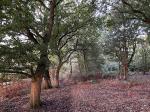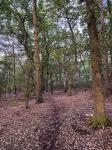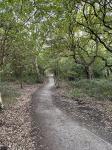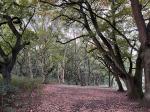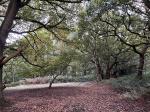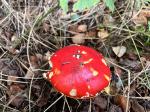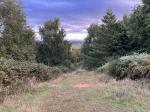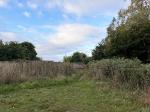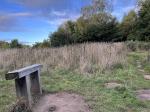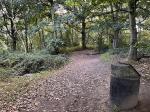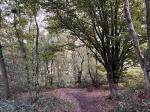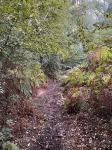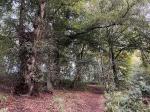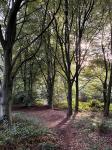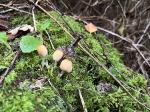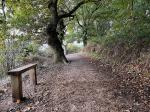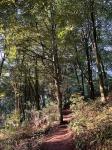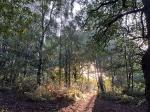Brayton Barff Through the Seasons.
Set in the Vale of York, South West of the market town of Selby and between the villages of Thorpe Willoughby and Brayton, lies Brayton Barff, a sandstone Hill approximately one hundred and fifty feet in height which was formed by glacial movement during the last Ice Age. It is a significant landmark in an otherwise flat landscape.
Today the site is primarily owned by Yorkshire Water with Selby District Council owning a small patch of the land adjacent to the A63 Selby bypass. A large underground reservoir occupies the centre of the site which delivers water to around 4.7 million customers throughout Yorkshire.
Within the Barff woodland over 40% of the trees are Sessile Oak which are generally found in semi natural woodlands in the north of the country. These trees are so called because its acorns are not held on stalks, like those of the English Oak (Pedunculate), but attached directly to the outer twigs. There are also several English Oak trees as well as some cross-hybrid oaks. These trees are known to support many species of flora and fauna, invertebrates, mosses, lichen and fungi.
During the Victorian times it is thought that the shipbuilders on the east coast would come over to the Barff for selected cuts of timber to build their sea going vessels.
The Barff also has a variety of other trees including Silver Birch, Beech, Sycamore, Holly, Rowan, Scots Pine, Alder, Hawthorne and European Larch. There are also several Yew, Willow, Hazel, Horse Chestnut and Wych Elm. As with similar woodlands there are a variety of bushes, including Honeysuckle, Elderberry, Gorse, Broom and Buddleia.
The history of Brayton Barff is quite vague, apparently during 1803 a beacon was lit on the Barff when the country was threatened with an invasion by Napoleon. In May 1935, to celebrate King George V's Silver Jubilee, a Bonfire was lit on the Barff as part of the celebrations.
Early issues of Ordnance Survey Maps dated 1903 clearly show a rifle range on the Barff, extending out to Mill Lane. During the 
Between 2001 – 2004 the A63 Selby bypass, 10km twin lane single carriageway was constructed which severed the South West corner of the Barff, adjacent to Selby Golf Course and resulted in a slight redesign of several holes on the golf course. Wooden fencing was erected as a result of this new road running alongside of the Barff and a footbridge constructed over the ‘new road’ following the line of the Bridal way which extends from Mill Lane. Around 2005/2006 a definite 2metre wide limestone aggregate footpath was laid forming a circular path around the outer edges of the woodland. This footpath is approximately 1.2 miles in length and takes about 30 minutes to circumnavigate at a leisurely pace.
In 2012 the Barff was declared an Ancient Oak Woodland and as such throughout 2012 and 2013 significant work had been carried out by the relevant agencies to cut and remove large swathes of non-native trees, creating at that time huge scars on the landscape. Some three years later the planting of the native trees have become well established and are flourishing. Ongoing maintenance work on the footpath around the bottom of the Barff was completed during the Summer of 2016.
A second phase of woodland maintenance commenced during the Autumn of 2019 with the removal of many old and diseased trees and the cutting back of the Gorse and Broom bushes, especially adjacent to the ‘bypass trail’, this work continued through till March 2020 with re planting continuing into April 2020.
Brayton Barff is a popular site for walkers and bird watchers alike and a path circling the outer perimeter of the Barff makes a pleasant thirty minute walk, giving views looking over towards Selby and the village of Brayton as well as the power stations of Drax and Eggborough..jpg)
For the early risers it is a great place to see some stunning sunrises over the villages of Brayton looking towards Drax Power Station, the same with the Sunsets looking over towards Eggborough and Monk Fryston.
The Barff changes with the Seasons and every visit can reveal something new, the woodland is a haven for wildlife. Records show that since 1982 one hundred and twelve species of bird have been seen in the woodland and at least 40 of those have bred here, including Tawny Owl, Buzzard, Green Woodpecker, Spotted Flycatcher, Goldcrest and Nuthatch to name just a few. On average over 70 species of bird are recorded each year. Further details of the bird life on the Barff can be found on the Brayton Barff Group Facebook page, especially the posts from Derek Cooper. Today ‘The Friends of Brayton Barff group’ led by Derek and a small team of volunteers help keep and maintain the cleanliness of the site as well as recording the wildlife and bird sightings.
The Barff is also home to fifteen different species of mammals, including Muntjac Deer, Pipistrelle Bat, Fox, and Field Vole.
Over eighty species of plant and wildflowers have been recorded, included Bee Orchid, Northern Marsh Orchid, Wood Anemone, Marsh Ragwort, Bluebell, White Bluebell, Bittersweet and Purple and White Foxgloves. Over twenty species of Butterfly have been recorded, including Marbled White, Brown Angus, Speckled Wood, Comma and Brimstone.
During the Autumnal months fungi thrives in this woodland environment, species including Fly Agaric, Beefsteak Tree Fungi, Chicken of the Wood, Sulphur Tufts, Stinkhorn, Ink cap, Puffballs and Hoof Bracket are just some of the many varieties that can be found here.
Click on the galleries shown below to expand the albums.
September 2022
I always enjoy this time of year on the Barff, the start of Autumn, shorter days, cold damp dewy mornings, wet grass and watching the Barff as it prepares itself for the onset of winter.
The hosepipe ban continues at home and the lack of rainfall of late has had quite an effect on the trees and plants on the Barff, the Brambles in particular. Many of the trees started shedding their leaves much earlier than normal, and what looked like being a bumper crop of Brambles this year has ended with much of the fruit being shrivelled up due to the lack of rain during July & August. The Oak trees seem to have coped well with the ‘extreme’ weather by producing a bumper crop of Acorns, the sloping ground around the old Oak swing tree opposite the pump house has, as the month progressed, become quite treacherous to walk across, due to the fallen acorns acting like marbles on the uneven ground, care has to be taken whilst walking past this beautiful tree. The Holly bushes are also carrying lots of fruit as are the Rowan trees. On the other hand, Elderberry bushes seem to have struggled with much of their fruit shrivelling up similar to the Brambles before ripening.
Fungi has started to grow at an alarming rate, favouring the wet, humid weather of late, Fly Agaric, Sulphur Tuft and Shaggy Parasol, to name but a few, the latter quite prolific all over the woodland, though the Fly Agaric seems to be is more selective where it pops up and is a little harder to find.
One morning, mid-month, I was on the Barff with Meg & Gracie for 5.15am, quite early, it was very dark, no moonlight, very still and extremely humid for this time of year. we’d been walking for about thirty minutes, all was quiet, until my portable headlamp disturbed a Tawny Owl in the deep woodland adjacent to the old pumping station, I must have startled it as it started to alarm call with its distinctive screeching call, no hooting, just a continuous screeching, quite a scary sound at that time in the morning, I can only think I must have got quite close to it whilst it was feeding, fortunately after about two – three minutes it settled down. I quite frequently hear the Tawny’s calling each other around 6.00am in the morning amongst the trees, in fact on a couple of occasions this month, we have had a pair visit our garden just after midnight, they sat at opposite ends of the garden amongst the tall trees and called to each other, wonderful to hear, though not when you are tucked up in bed trying to get to sleep! .
The Barff Buzzard has been quite active of late, I must have heard it two or three times a week this month always deep in the woodland under the tree canopy.
Weather wise has been quite varied, the first week or so has been quite mild and humid, with temperatures ranging between 10C – 18C, I have only had to wear a waterproof jacket on a couple of occasions, with the majority of the rain falling overnight. After the 12th the mornings became distinctly cooler and wetter as we came to the end of the month.
The Barff bracken is dying back at an alarming rate, leaving its brown, withered fronds covering the woodland floor.
On a more pleasant note, I have witnessed some beautiful sunrises, the sunrise at the beginning of the month was around 6.15am and as the month comes to end and the days get shorter the sun rises a little later at 7.00am, I’ll soon be walking round with the headlamp on!
There are still many woodland birds to be seen and heard, Blackcaps and Chiffchaff are still here, hanging on to the last remnants of the warmer weather before they fly off to Africa, though what with climate change and ‘warmer winters’ in this country, some will no doubt over winter over here.
Greater Spotted Woodpeckers can be heard and seen most days, as can Robin and Wrens, Dunnocks and Blackbirds, Great and Blue Tits, Goldcrest and Nuthatch. Tawny Owl seems to have a continuous supply of Bank voles at the moment, little holes only about 30mm in diameter can be seen alongside most of the tracks in the woodland. The voles are prolific breeders and can have up to three or four litters a year, each with three to five young and as they don’t hibernate provide an ideal food source for the owls and other woodland predators throughout the year.
Alas the wetter weather is beginning to affect the tracks on the Barff with puddles forming in several areas and with the large amounts of overnight rain of late are just beginning to form lots of muddy puddles, it looks as though I might be digging out the wellies during October.
|


